
A Lean Start-up Approach to Unite the C-Suite
Everybody knows why innovation is tough for large organisations. All the literature is the same, from Clay Christensen to the latest business magazine.
You were innovative when you were small and had a new product or service, or cracked into a brand new market. Inevitably, as you got larger, silos developed, hierarchies emerged, processes and procedures got solidified around optimising the current business model and you tweaked the existing product set. Few managers or employees are incentivised to really try something radically new or take real risks; almost everybody is goaled on keeping the existing wheels spinning around faster and faster.
Despite all the management mantras in favour of “fail fast”, how many failures are actually tolerated (not to mention encouraged) in your corporate leadership culture?
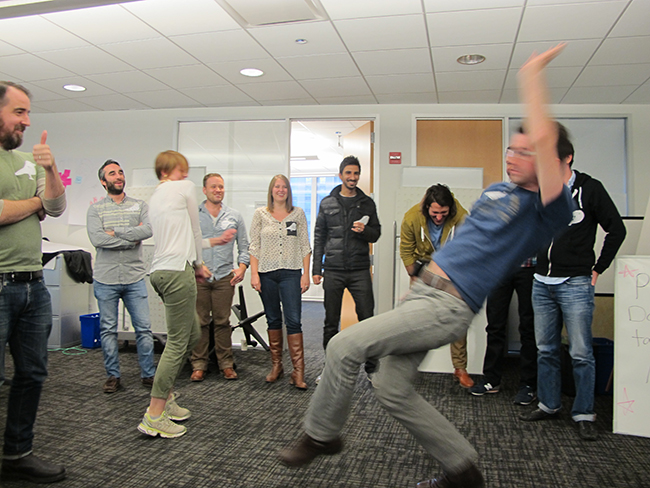
Given the exponential rate of business change in recent years, there has been renewed attention to the sources of enterprise innovation. A spotlight has focused on the evolving role of C-suite executives to help crack the innovation nut and in creating cultures that foster innovation.
Thoughtworks has had considerable success globally in the past few years helping our clients drive their innovation agendas through a combination of methods: a “Lean Startup” approach (popularised by Eric Ries’ book of that name), and an application of Design Thinking and Systems Thinking as the “intellectual fuel” to drive rapid, iterative prototyping and getting fast feedback from real customers. And those customers are increasingly sophisticated, have real time access to ever greater sources of information and purchasing options, are tech savvy and quick to change loyalties.
We believe the time is ripe (indeed, for most organisations facing extreme volatility, even over-ripe!) for a renewed level of collaboration among Chief Executive Officers (CEOs) and, in a digital sense, perhaps their two most key, C-level allies: the Chief Information Officer (CIO) and Chief Marketing Officer (CMO).
The Challenges of Enterprise Innovation
The turmoil we are witnessing in most corporations is intimately connected to the multiple challenges of enterprise innovation. Modern businesses have to contend with at least three levels of innovation: business model innovation, management model innovation and product and service innovation.
- Business models are dissolving and being created at blinding speed. The statistics are well known. The life expectancy of companies on the Fortune 500 has fallen from over 60 years to less than 15 years and is rapidly heading for 5 years. Business models that lasted for decades are now down to an average of about 8 years. Nobody wants to get Kodaked, but in most companies “escaping the gravitational pull of last year’s operational plan” (Geoffrey Moore, “Escape Velocity”) is a major and daunting challenge.
- Management models for the 21st century have to change. The 20th century management model documented by Frederick Winslow Taylor in his 1911 work “Scientific Management” (and championed by such industry magnates as Henry Ford, Andrew Carnegie, Andrew Mellon and others), is well and truly dead, at least for knowledge-intensive industries. A plethora of modern management literature, including Gary Hamel’s “What Matters Now” and “The Future of Management”, Stephen Denning’s “A Leader’s Guide to Radical Management” among others argue that recruiting and retaining the best knowledge workers now requires something far better than “carrot and stick” incentives. Once knowledge workers’ basic financial needs are taken care of, an entirely new set of motivators comes to the fore. In Dan Pink’s terminology, the desire for autonomy (“don’t stand over me and tell me what to do every minute”), mastery (“I want to get better at my craft every day”) and purpose (“I want to feel like my work is part of achieving a greater goal”) become the major drivers for recruiting, motivating and retaining top knowledge workers, who have lots of choices.
Hamel’s acclaimed article “Moonshots for Management “ [1] (reprinted in his book “What Matters Now”) proclaimed as its No 1 “moonshot”:
“Ensure that the work of management serves a higher purpose. Most companies strive to maximize shareholder wealth—a goal that is inadequate in many respects. As an emotional catalyst, wealth maximization lacks the power to fully mobilize human energies. It’s an insufficient defense when people question the legitimacy of corporate power. And it’s not specific or compelling enough to spur renewal. For these reasons, tomorrow’s management practices must focus on the achievement of socially significant and noble goals.”
- Product and service innovation in the digital era has become a mandate for every company. Virtually all companies become technology companies, heavily reliant on software to create and deliver goods and services to their customers. As Netscape founder Marc Andreeseen says: “Software is eating the world”.
Digital products and services can be rapidly brought to market and quickly morphed. And they are easily copied. The implication for corporate innovation strategies is profound. In the words of Rita Gunther McGrath[2]:
“The dominant idea in the field of strategy — that success consists of establishing a unique competitive position, sustained for long periods of time — is no longer relevant for most businesses. They need to embrace the notion of transient advantage instead, learning to launch new strategic initiatives again and again, and creating a portfolio of advantages that can be built quickly and abandoned just as rapidly. Success will require a new set of operational capabilities.”
Faced with these overlapping innovation challenges, the nexus between IT departments and their counterparts in the business/marketing and product management areas must merge more tightly around the interests of serving customers with more remarkable/engaging products and services and differentiating, delightful and memorable experiences. The ones you recommend on Yelp, tweet about and “like” on Facebook.
Forrester Research analyst Sheryl Pattek says: “CMOs and CIOs are on the cusp of transforming their firms into customer-obsessed enterprises”. [3] The alternative will be going the way of Kodak, Borders and Blockbuster.
Getting the Mix Right in the C-Suite
The overwhelming pressure for unified leadership around the innovation imperative is driving CEOs, CMOs and CIOs to collaborate in a more intense and nuanced way than ever before.
Consider some of the following survey results:
- IBM’s 2012 global CEO study revealed that “71% of CEOs now believe technology change is their biggest issue”. This was the first time since IBM began its CEO survey that technology has surfaced as a CEO’s #1 issue.
- A Harris Interactive survey of Fortune 1000 CEOs revealed that more have experienced innovation coming from IT than from marketing over the past 10 years (44% to 33%) and the gap on expected sources of innovation over the next two years widens even further in favour of IT (63% vs 26%)[4]
- Gartner has predicted that by 2017 CMOs will spend more money on information technology and analytics than CIOs (which Accenture notes is “a remarkable development considering that CMOs regard digital orientation as their weakest capability”.) [5]
- Despite the obvious need for IT/business collaboration to meet the digital innovation imperative, only one in 10 marketing and IT executives say collaboration is at the right level. [6]
We believe these results reflect a redefinition required in the overlapping responsibilities of C-suite executives. We are now in an era where mass media advertising and traditional marketing confronts an ever-more indifferent if not hostile consumer audience (who are more empowered than ever to obtain product/price information and real time customer reviews).
Marketing professionals are having to re-examine their strategies and are seeking out empowering technologies to deliver relevant products and services across multiple channels and highly personalised messages about them. And IT professionals, many of whom have been focused for years on cost constraint and “keeping the lights on”, are realising their roles demand a renewed focus on actual customer desires and needs, not just system and cost optimisation. And CEOs are realising stewardship of the digital innovation imperative is probably not something that can be delegated but must be at the forefront of all executive thinking.
Disciplined Experimentation: Lean Start-Up Techniques for the Enterprise
Recognising that senior managment executives must work more hand-in-hand on overlapping areas of responsbility is only a starting point. The real question is: how to innovate?
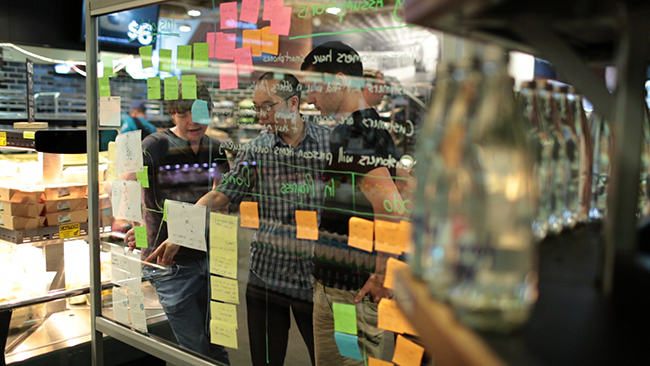
We see dozens of companies establishing Chief Innovation Officers with no real budget and little authority with line of business managers. We see “innovation groups” that meet often, brainstorm ideas, but have no systematic way of working out which to proceed with. Perhaps worst of all, we often see organisations where the HiPPOS (the most highly-paid person in the room) actually have the authority and budget to arbitrarily decide which ideas to invest in, often on a hunch rather than using data-driven decision-making. In most organisations, even those with an aggressive innovation agenda, actual innovation is still largely left to serendipity.
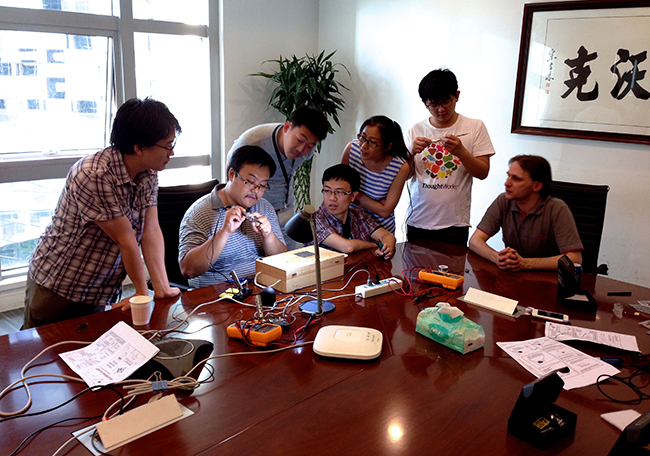
Eric Ries’ 2011 best-seller “The Lean Startup” proposed an approach to innovation that is familiar to everyone in Agile software development. Don’t try to build the all-singing-and-dancing, fully-featured product that you think your customers might want (you will often be wrong!). Instead, Ries outlined a simple, three-step process particularly applicable to product and service innovation:
- Develop the smallest possible thing (the “Minimum Viable Product”) you think your customer might pay you for (and that you could learn from)
- Get it into the marketplace as fast as you can (a host of modern technologies and Agile development techniques allow rapid prototyping, delivery and early release cycles) and learn from it.
- Iterate rapidly. If feedback is mixed, modify (pivot) and learn. If the idea tanks, desist: at least you haven/t wasted a lot of time and money. If feedback is positive, amplify the product and keep going… and keep learning!
This form of disciplined experimentation (or “hypothesis-driven development”) allows for low-cost prototyping and feedback-driven quick product development cycles. The Lean StartUp approach is now being taught at over 20 graduate business schools in North America and Europe. [7]
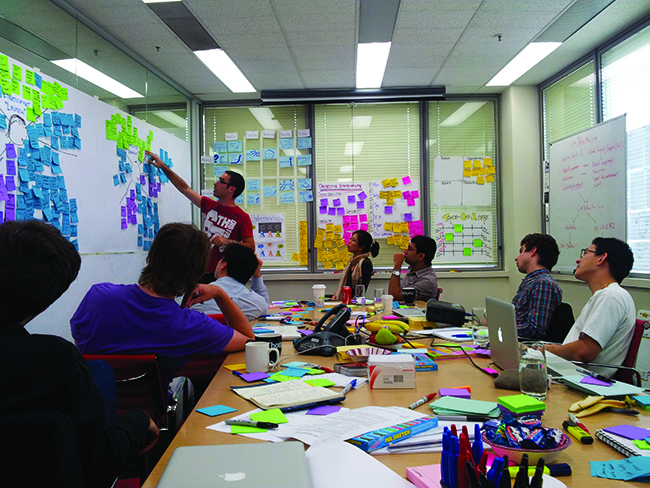
Thoughtworks has been applying similar methods (based on over a decade of experience with Agile software development) to assist our clients in developing new innovative business models, management approaches and new products and services. We do this to help them not only disrupt their existing markets and fight off would-be disrupters but also to discover/create whole new markets.
In the UK, Thoughtworks worked out with lastminute.com (a division of Travelocity) to develop a new mobile application for last-minute bookings at hotels, flights, etc. We set up a “pop up design studio” in the lobby of a London hotel to prototype potential solutions and then took ideas back into the client’s innovation lab to conduct further user testing during every week of development. The result was a new mobile experience which dramatically increased both conversions and the value of bookings in the very first month after release.
- A new generation Hand Held Terminal that operates on the Android operating system
- A dynamic route planning system that helps drivers and pilots optimise their deliveries
- A Business Activities Managing System that improves management efficiency and transparency
- A redesigned and rebranded corporate website that changes the way SF Express integrates its many varied services
At Australia’s largest retailer, Woolworths, Thoughtworks established an on-site design studio in an experimental “small format” store to trial new products and services. In just five days, we prototyped and tested with in-store users a mobile application where customers could scan barcodes and pay for their purchases with their mobile phone, avoiding the tiresome check-out experience entirely. We then pivoted to trial an i-Pad-based recipe concept to boost sales through identifying the multiple items customers would need to deliver a particular “meal deal”. Through an integration of software and hardware, LED lights “lit up” the items shoppers would need on the same shelving unit where the i-Pad recipe was placed, leading to ease of collection, purchase and delighted customers.
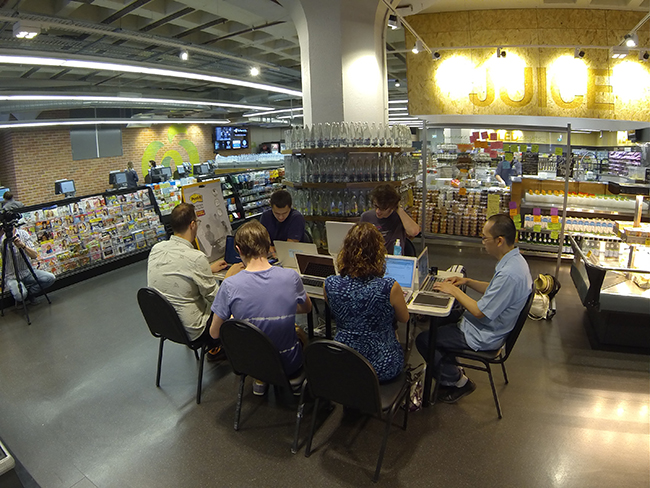
In North America, Thoughtworks partnered with the Natural Markets Food Group (NMFG) to completely redevelop the in-store and digital experience for the launch of their new Toronto store in one of the highest trafficked malls in North America. The new 18,000 square foot multi-kitchen eatery is combined with an 1,800 square foot “grab and go” organic market. Consumer research and prototyping helped ensure a service design and solution architecture that could meet customers’ expectations across multiple end points. In just five months, the new facility launched featuring:
- Online ordering, a mobile app, express pickup and ordering kiosks to minimise queues and provide customers with convenient options to order and pay
- Digital menus to facilitate customer ordering and enable the store to make real time price/menu adjustments
- "Grouping" technology in the form of a Market Pass that allows groups/families the ability to order from different food stations while paying via a single smartphone; allowing groups to spend more time together rather than in queues
- A streamlined POS system with cross-platform integration that vastly improves inventory management by capturing sales in real time and eliminating the need for physical counts
In Brazil, Thoughtworks developed a sophisticated Electronic Medical Record (EMR) system for the University Hospital in Mirebalais, Haiti. The EMR performs key hospital functions, including patient registration, check-in, and reporting, and may also store and manage patient records. After a week of interactive workshops with the client, Thoughtworks started to work on an MVP (minimum viable product).
The system had to be easy and intuitive to use, since medical staff can’t let technology compromise patient care. For every new piece of software built, the designers iterated on quick, multiple, different solutions and evaluated with the entire team which one would better solve the problem. After some iterations, the team travelled to Haiti to test what they were building with real users at the hospital. At this point they’re able to break assumptions and adjust the system to users’ needs, such as making the application largely keyboard driven, given that a mouse navigation caused problems for users, some of whom had little or no computer literacy. Time-consuming paperwork was one of the biggest challenges the staff faced and improving records means saving lives – one patient at a time.
Design Thinking
In each of these cases, we are helping clients innovate by using design thinking to drive new product/service development, systems thinking to streamline their value chains and empowering technology to rapidly prototype and bring new ideas to market. These are examples where product managers, marketers and technologists combine their talents and capabilities with a focus on addressing customer interests and desires (sometimes unanticipated and unknown ahead of time even by customers themselves) that drive competitive advantage.
While the precise relationship between C-suite executives remains algebraic and will have to be worked out in each company, the future direction for success seems clear. Those organisations which unite the marketing insights that can both make sense of customer behavior (including big data analytics) and how to influence it (through high-touch and high-fidelity experiences that inspire customers across all touchpoints) will be the ones best suited to weather the turbulent markets still ahead. The sparkplug may be a CMO, a CIO or some combination of other roles. And a CEO without a digital vision will almost certainly have a short-lived tenure.
The real question is: who will be your organisation’s Chief Digital Storyteller?
Disclaimer: The statements and opinions expressed in this article are those of the author(s) and do not necessarily reflect the positions of Thoughtworks.














